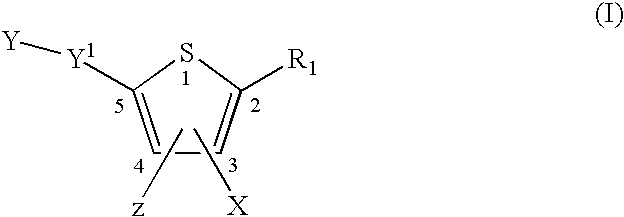Compounds and methods for the treatment or prevention of Flavivirus infections
a technology of compounds and flavivirus, applied in the field of compounds and a method for the treatment or prevention of flavivirus infection, can solve the problems of blood contamination with hcv, and achieve the effect of inhibiting or reducing the activity of viral polymeras
- Summary
- Abstract
- Description
- Claims
- Application Information
AI Technical Summary
Benefits of technology
Problems solved by technology
Method used
Image
Examples
example 1
Preparation of 3-(2-Chloro-benzenesulfonylamino)-5-phenyl-thiophene-2-carboxylic acid, compound #29
[0230]
Step I
3-Amino-5-phenyl-thiophene-2-carboxylic acid
[0231] To a suspension of 3-Amino-5-phenyl-thiophene-2-carboxylic acid methyl ester (5 g, 21.459 mmol) in a mixture of THF:MeOH:H2O (3:2:1, 75 mL), 1N aqueous solution of LiOH.H2O (64 mL, 64.378 mmol) was added. The reaction mixture was stirred at 85° C. (external temperature) for 4 h. Solvents were removed under reduced pressure and the residue was partitioned between water and ethyl acetate. The water layer was separated and acidified with 1N HCl solution and then ethyl acetate was added to it. The organic phase was separated, dried (Na2SO4) and concentrated to obtain 3-Amino-5-phenyl-thiophene-2-carboxylic acid (4.15 g, 88%) as a yellowish solid. 1H NMR (DMSO-D6, 400 MHz): 7.59 (d, 2H), 7.40 (m, 3H), 6.92 (s, 1H)
Step II
3-(2-Chloro-benzenesulfonylamino)-5-phenyl-thiophene-2-carboxylic acid
[0232] 3-Amino-5-phenyl-thiophene...
example 2
3-(Toluene-2-sulfonylamino)-5-p-tolyl-thiophene-2-carboxylic acid, compound #62
[0235]
Step I
3-(bis-(Toluene-2-sulfonyl)-amino)-thiophene-2-carboxylic acid methyl ester
[0236] To a cold (0° C.) stirred sodium hypochlorite (NaOCl, 10.8% commercial bleach, 124 mL, 180.00 mmol) solution was added o-thiocresol (2.239 g, 2.12 mL, 18.0 mmol). To this vigorous stirred solution was added conc. Sulfuric acid (caution! extremely exothermic, 92 g, 50 mL, 938 mmol) dropwise. The resultant yellow reaction mixture was stirred for 2 h at the same temperature, diluted with water (50 mL) and dichloro-methane 50 mL. The organic solution was separated, aqueous solution was extracted with CH2Cl2 (2×50 mL). The combined organic extracts were washed with water, brine and dried. Evaporation of the solvent under reduced pressure furnished the 2-methylsulfonyl chloride (3.13 g, 91.5% yield), which was used in the next step without purification. 1H NMR (CDCl3, 300 MHz) 8.07 (td, J=7.3, 1.5 Hz, 1H) 7.61 (tt, ...
example 3
3-(4-Choro-benzoylamino)-5-phenyl-thiophene-2-carboxylic acid compound #72
[0245]
Step I
3-(4-Chloro-benzoylamino)-5-phenyl-thiophene-2-carboxylic acid methyl ester
[0246] To mixture of methyl-3-amino-5-phenylthiophene-2-carboxylate (100 mg, 0.428 mmol) in anhydrous pyridine (4.3 ml) was added p-chlorobenzoyl chloride (71 μl, 0.556 mmol). The mixture was stirred for 3 hours at room temperature and concentrated. Purification chromatography (silica gel, hexane to hexane:ethyl acetate; 95:5) gave 145 mg (91% yield) of 3-(4-Chloro-benzoylamino)-5-phenyl-thiophene-2-carboxylic acid methyl ester. 1H NMR (CDC3, 400 MHz) 8.54 (s, 1H), 7.99-7.96 (m, 2H), 7.73-7.71 (m, 2H); 7.52-7.50 (m, 2H), 7.46-7.39 (m, 3H), 3.95 (s, 3H).
Step II
3-(4-Chlorobenzoylamino)-5-phenyl-thiophene-2-carboxylic acid
[0247] To a mixture of 3-(4-Chloro-benzoylamino)-5-phenyl-thiophene-2-carboxylic acid methyl ester (30 mg, 0.081 mmol) in 1 ml of a 3:2:1 solution made with tetrahydrofuran, methanol and water respectiv...
PUM
| Property | Measurement | Unit |
|---|---|---|
| diameter | aaaaa | aaaaa |
| temperature | aaaaa | aaaaa |
| pH | aaaaa | aaaaa |
Abstract
Description
Claims
Application Information
 Login to View More
Login to View More - R&D
- Intellectual Property
- Life Sciences
- Materials
- Tech Scout
- Unparalleled Data Quality
- Higher Quality Content
- 60% Fewer Hallucinations
Browse by: Latest US Patents, China's latest patents, Technical Efficacy Thesaurus, Application Domain, Technology Topic, Popular Technical Reports.
© 2025 PatSnap. All rights reserved.Legal|Privacy policy|Modern Slavery Act Transparency Statement|Sitemap|About US| Contact US: help@patsnap.com



